What’s the Difference Between Balanced and Unbalanced?
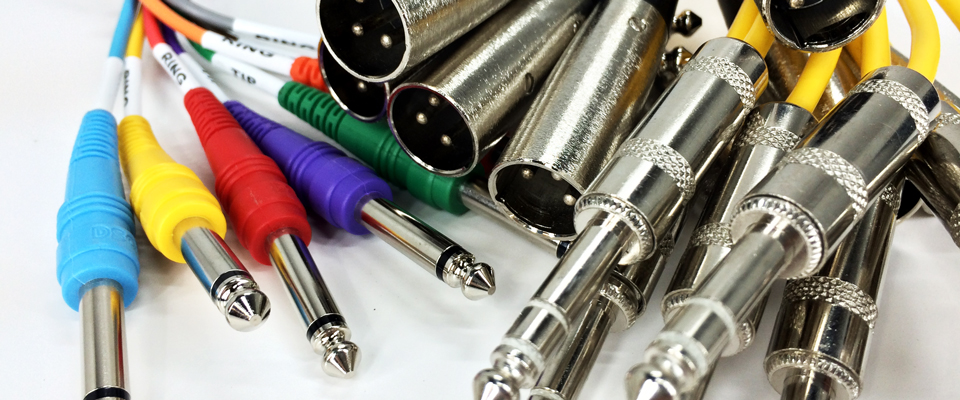 The cables used in an audio system—and how they’re put together—can have a major impact on the sound of the system. Every cable in an audio system has the potential to add noise and to compromise the sound quality of the components it connects, so it’s important to use the right cable for the right job. That starts with understanding the kinds of signals the cables are carrying.
The cables used in an audio system—and how they’re put together—can have a major impact on the sound of the system. Every cable in an audio system has the potential to add noise and to compromise the sound quality of the components it connects, so it’s important to use the right cable for the right job. That starts with understanding the kinds of signals the cables are carrying.
There are two main issues to consider here: the level of the signal and the signal type. We’ll set aside signal level for a future post and focus for now on whether the signals are balanced or unbalanced.
Unbalanced Cables and Signals
An unbalanced cable consists of two connectors with two conductors each, connected by two wires inside the cable—a signal wire and a ground wire. You can quickly (in most cases) identify a cable designed to carry an unbalanced signal by its connectors: because each wire has to terminate at the connector with its own contact point, an unbalanced cable requires only two conductors at the connector. A standard TS (or “tip-sleeve”) guitar cable is the unbalanced cable you’ll run into on stage most. Standard RCA cables used for many AV components are also unbalanced cables.
Inside the cable itself, the signal wire is typically in the center of the cable with the ground wire surrounding it. The ground wire serves two functions—it carries part of the audio signal and serves to shield the main signal wire to some degree from outside interference from noise such as the hum from lights and transformers, as well as RF (radio frequency) interference that comes from TV and radio transmissions. It does a decent job of rejecting noise, but unfortunately, the wire itself also acts like an antenna and picks up noise.
Unbalanced cables work great for connecting a guitar to an amp, for instance, but because they are not very good at suppressing noise from outside interference, unbalanced cables should have a maximum length of 15-20 feet (4-6 meters), especially when used in noisy environments and with signals that are low level to begin with, such as those from keyboards, guitars, MP3 devices and so on.
Balanced Cables and Signals
A balanced cable, by contrast, has three conductors in the connector and three wires in the cable: two signals wires plus a separate ground wire. As in the unbalanced cable, the ground wire still surrounds the signal wires and is used as a shield against interference. But what makes a balanced cable special is the way the gear utilizes that extra signal wire.
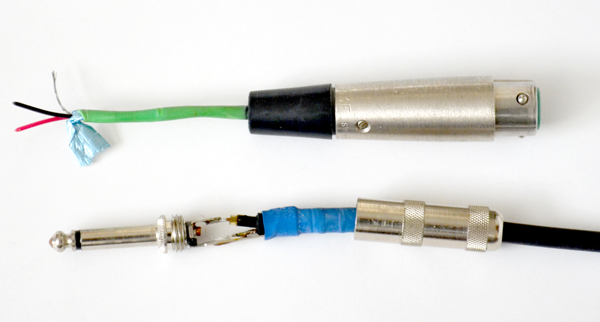
A balanced XLR cable (above) showing its two signal wires and its ground (with a foil shield) compared with a typical 2-conductor TS guitar cable (below).
Balanced cables use two signal wires; both carry a copy of the signal, but the two copies are sent with their polarity reversed. If you sum two signals that are identical but are reversed in polarity, the signals cancel out, leaving you with silence. (Just like adding positive and negative numbers: +15 added to -15 equals 0.)

Adding a signal (LEFT) to an inverted copy of itself (RIGHT) results in a canceled signal, as positive peaks in the original signal correspond to an equally negative peak in the inverted signal (and vice versa).
So why would you want audio gear that flips the polarity of your signal? In this case, because the receiving gear will flip the inverted signal back into its original orientation. But because both copies of the signal picked up the same noise as they traveled along the cable—and that noise is identical on the two wires in the cable—flipping the polarity of what arrives at the receiving gear will produce the original signal intact and noise which now has reversed polarity. Summing that gives you a welcome result: signal that’s preserved and noise that’s canceled.

Balanced wiring uses two signal conductors plus a ground, allowing noise picked up along the way to be canceled through polarity inversion.
Because of this, balanced cables can support much longer cable runs; 50 to 100 feet (15-30 meters) is not uncommon, though even shorter runs will often use balanced wiring to protect against noise. The wiring for microphones, and the interconnect cables between consoles, signal processors, and amps, etc., in a pro sound system or recording studio environment are typically of the balanced variety. Standard connectors designed for use with balanced signals are XLR and TRS (or “tip-ring-sleeve”).
Use the Right Cable for the Right Signal
It’s important to note that using a balanced cable on an unbalanced signal gives you no benefits. The jacks on the gear on both ends of the cable must be designed for balanced signals as well; otherwise there’s no circuitry to do the polarity inversion that produces the noise cancellation. On the flip side, however, using an unbalanced cable with gear that expects balanced signals will “work” (in the sense that audio will go from point A to point B), but the signal will be unbalanced and susceptible to the same noise as any unbalanced signals. Check the documentation of your gear (or the labels on the gear itself, near the jacks) to determine what type of signal a given jack is designed to support, if you’re not certain.
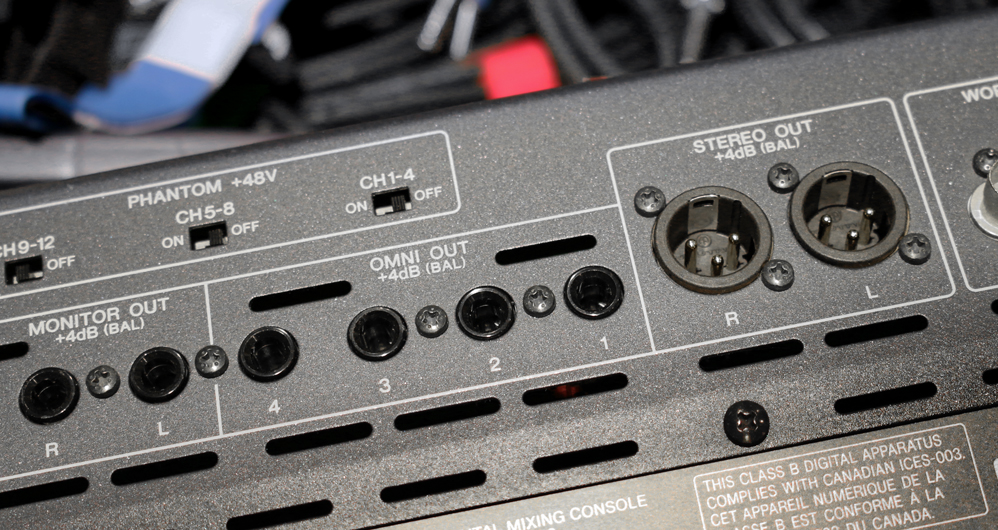
The output jacks on this console all provide a balanced signal, even though they use two different types of connectors.
So what do you do when you need to go a longer distance with an unbalanced signal? In some cases, a wireless rig is a great (though potentially pricey) option. The other option is a direct (or “DI”) box. Learn more about direct boxes in this post.


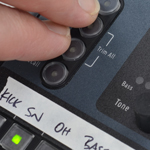
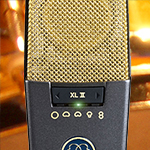

Thanks for the explanation. One question – if a copy of the same signal is sent in reverse polarity which then gets converted back to its original polarity at the end of the run – are you then receiving ‘double’ signal? Or is the signal split at the beginning of the run, one half is flipped, then flipped back, then you have the sum of 1 signal and no noise? Thanks
When the reversed original signal is returned to its normal polarity, the noise picked up by the cable gets canceled because its polarity is now opposite of that on the other signal wire in the cable.
Based on what read in this article (and the DI boxes article), seems i may be doing my setup wrong. so i just want to double check i understood this correctly. I have an Apollo twin interface i use to send my soft synths audio in MainStage to the front of house when playing at my church. After reading through this article, i went back and read the manual and its seems the 1/4″ outs on the interface are TRS balanced. Up to this day i have been running 1/4″ TS cables from the outs of my interface to a DI box and then XLR cables from DI box to stage box. Based on what this article says, i really do not need the DI box or the TS cables for this particular set up… right? It seems i am only converting balanced signal from my apollo to unbalanced to the DI and then converting it back to balanced to stage box…? Can i just get some balanced 1/4″ TRS to XLR cables and plug them directly from my interface outs to the stage box, or is there a reason i would still need to use a DI along with balanced 1/4″ TRS cables?
I know TR cables loose signal when run long lengths and that XLR cables can run long lengths without loosing much signal. Which is why the 1/4″ TS cables and Di box came in handy when playing directly from a Yamaha synth. But if i use 1/4″ TRS to XLR from my interface to stage box, will the cables be able to run long lengths without loosing signal?
Your audio interface is providing a balanced line-level signal. A 1/4-inch TRS to XLR cable should be enough to connect it to the inputs of a mixing console. Remember, the stage box and the multi-core cable that runs to the FOH console is just a fancy extension cord for audio. The console should be able to accept your line-level audio signal.
Fantastic easy explanation, thanks!
Very Well eXplained and really helpful, since no one could ever explain it to me that way !!! Good job !!
My DAC has RCA and XLR out. Currently it goes to an RCA pre-amp.
I may change the pre-amp, that could be XLR.
Is there any point in going balanced (XLR) from DAC to pre-amp with 1m cable and then unbalanced (RCA) to amplifiers.?
Using balanced wiring between devices or components will minimize noise in the system.
So I just want to make sure it is ok to use an unbalanced cable in a unit that has balanced in/ outputs. I’m running a BBE 882i sonic maximized in my effects loop of my guitar amp. If I understand correctly it will work just fine right? Thanks.
Most balanced devices can work with an unbalanced input. Check the product’s documentation for specifics regarding cables, pinouts, etc.
Clear explanation of what happens when you use a balanced cable with unbalanced connections and viceversa. Now, what happens if you have a balanced source and an unbalanced input? I’m thinking of a situation where your XLR microphone sends a balanced signal and your camera’s 3.5mm input audio jack accepts an unbalanced signal. You would certainly need an XLR to 3.5mm adaptor cable but, would that be balanced or unbalanced? Or are both types of XLR to 3.5mm adaptor cables available?
Good question; that’s a situation that a lot of people encounter.
When you use an adapter to change a balanced XLR connection from a mic to a camera’s unbalanced TS (tip-sleeve) 3.5mm mic input, an unbalanced connection results. What actually happens is that the hot/positive (+) and ground from the XLR get connected to the corresponding hot/positive/tip (+) and ground/sleeve on the 3.55mm plug while the cold/negative (-) connection from the XLR is shunted to ground or left unconnected at the adapter, effectively cancelling it. You get no noise reducing benefit from the balanced wiring coming from the mic in this case.
So if i plug unbalanced cable to source and the balanced side to a speaker… The noise would still be here?
Yes. If you start with an unbalanced source and an unbalanced cable (two wires) that signal will remain unbalanced when you plug it into a balanced input. A balanced circuit needs to be three wires (positive, negative, and ground) all the way through.
That WOULD be BALANCED! Although NORMALLY 3.5mm TRS connections are unbalanced, but with a camera audio input SPECIFICALLY, the 3 conductors TIp, RIng, & Sleeve represent the 3 pins in an XLR connection, just in a smaller form. Do NOT however try to use this cable to connect an iPod to an XLR input.
Thanks for the clear explanation. We bought a Bose tower system a few years ago and we’ve always experienced hiss from the speakers. My wife and I bought a couple of Audioline NpartyM battery/mains amps a few days ago as we do small community service gigs as well as larger venues where we use the Bose. Doing our initial intro playing around with the Audiolines we experienced heaps of hiss when we plug in our ukes, but nothing using xlr leads from the mics. The Audioline inputs require balanced leads and we used our standard TR leads – hence that hiss. (The penny didn’t drop until reading your article!!) So, we’re going to get balanced leads to plug our ukes into our Audioline gear, AND, we’ll replace the TR lead that was supplied with our Bose/Yamaha setup with a TRS balanced lead that will/should eliminate that annoying and very audible hiss. Thank you for shining light on our two noise issues – much appreciated.
it it best to get a balanced cable even if the equipment is not balanced-compatible? Is there any disadvantage of a balanced cable?
There is no advantage to having a balanced cable if the gear has unbalanced connections. A good example is the connection between a guitar and its amp. The guitar has two conductors, positive and shield, and so does the amp. Adding one more conductor to the cable will do nothing to reduce noise.
But is there any disadvantage? So if I carried a balanced cable in my bag, would work any WORSE than an unbalanced cable if the devices were not balanced? Just wondering if I need to carry 2 cables, or if a single balanced cable would cover me. Thanks again
In most cases, there should be no reason that the balanced cable would be worse than an unbalanced cable. But there are a few instances where the ground connection actually touches the negative connection instead of the ground (again, referencing 1/4-inch guitar gear and effects), so test first before finding out on the job that you have a cable that causes a problem.
Been looking a while ago for this explanation.
Found it now in a clear and very understandable way !!
Thanks for this!
Thanks, Jan! We’re glad it helped. Let us know if there are any other audio topics you’d like to know about. We take requests!